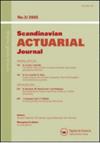Modelling mortality by continuous benefit amount
IF 1.4
3区 经济学
Q3 MATHEMATICS, INTERDISCIPLINARY APPLICATIONS
引用次数: 2
Abstract
ABSTRACT Mortality levels vary by benefit amount, and a common simplification is to group by non-overlapping ranges of varying widths. However, this ignores the continuous nature of benefit amounts and leads to discretisation error, i.e. heterogeneity within benefit ranges and step jumps at range boundaries. Another drawback of discretisation is that fitted parameters are not easily extrapolated to values outside the range of the experience data. To address these shortcomings it is often better to model mortality continuously by benefit amount. In this paper we present a method of modelling mortality levels continuously by a financial covariate such as pension size. We split the task into (i) a transform function to address the presence of extreme benefit amounts in actuarial data sets, and (ii) a response function to model mortality. Using as few as two parameters, the method avoids discretisation error and extrapolates to amounts outside the range covered by the calibrating data set. We illustrate the method by applying it to seven international data sets of pensioners and annuitants.通过持续受益量对死亡率进行建模
死亡率水平因受益量而异,常见的简化方法是按不同宽度的非重叠范围进行分组。然而,这忽略了收益数额的连续性,并导致离散误差,即收益范围内的异质性和范围边界的阶跃。离散化的另一个缺点是,拟合参数不容易外推到经验数据范围之外的值。为了解决这些缺点,通常更好的方法是通过获益量对死亡率进行连续建模。在本文中,我们提出了一种通过财务协变量(如养老金规模)连续建模死亡率水平的方法。我们将任务分为(i)一个转换函数,以解决精算数据集中存在的极端福利金额,以及(ii)一个响应函数,以模拟死亡率。使用少如两个参数,该方法避免了离散误差和外推量的校准数据集所涵盖的范围之外。我们通过将其应用于七个国际养老金领取者和养老金领取者数据集来说明该方法。
本文章由计算机程序翻译,如有差异,请以英文原文为准。
求助全文
约1分钟内获得全文
求助全文
来源期刊

Scandinavian Actuarial Journal
MATHEMATICS, INTERDISCIPLINARY APPLICATIONS-STATISTICS & PROBABILITY
CiteScore
3.30
自引率
11.10%
发文量
38
审稿时长
>12 weeks
期刊介绍:
Scandinavian Actuarial Journal is a journal for actuarial sciences that deals, in theory and application, with mathematical methods for insurance and related matters.
The bounds of actuarial mathematics are determined by the area of application rather than by uniformity of methods and techniques. Therefore, a paper of interest to Scandinavian Actuarial Journal may have its theoretical basis in probability theory, statistics, operations research, numerical analysis, computer science, demography, mathematical economics, or any other area of applied mathematics; the main criterion is that the paper should be of specific relevance to actuarial applications.
 求助内容:
求助内容: 应助结果提醒方式:
应助结果提醒方式:


